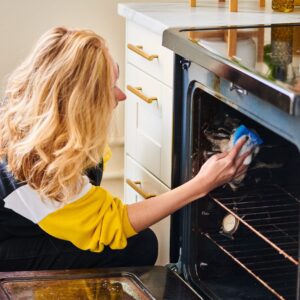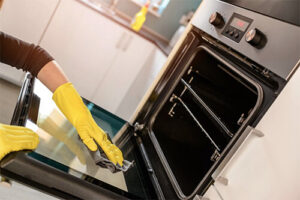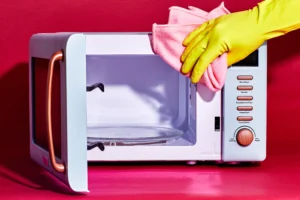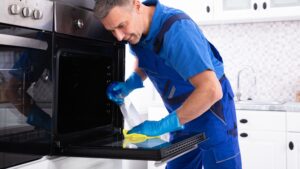Keeping your oven clean is essential for maintaining its efficiency, ensuring the quality of your food, and keeping your kitchen safe. Let’s explore why regular oven cleaning is important and the scientific principles that make it effective.
The Science Behind Oven Cleaning
- Thermal Decomposition:
- Self-Cleaning Ovens: Many modern ovens have a self-cleaning feature that uses high heat (around 900°F or 480°C) to burn off food residue and grease. This process, known as pyrolysis, turns the organic matter into ash, which can be easily wiped away once the oven cools down. The extreme heat breaks down the chemical bonds in the residues, effectively reducing them to ash.
- Chemical Reactions with Cleaning Agents:
- Baking Soda and Vinegar: This popular natural cleaning combination works through a mild chemical reaction. Baking soda (sodium bicarbonate) is a weak base, and vinegar (acetic acid) is a weak acid. When combined, they produce carbon dioxide gas, water, and sodium acetate. The bubbling action helps to lift grime and grease from surfaces. Additionally, baking soda’s abrasive texture aids in scrubbing away residues.
- Commercial Cleaners: Many commercial oven cleaners contain strong alkaline substances like sodium hydroxide (lye). These substances work by saponification, a process that breaks down fats and oils into soap and glycerol, making them easier to remove. The alkaline nature of these cleaners also helps to break down proteins in baked-on food, effectively dissolving stubborn residues.
- Mechanical Action: Physical scrubbing and wiping complement chemical cleaning. Abrasive tools like scrubbing pads or sponges help dislodge and remove softened grime and residues from the oven’s surfaces. The mechanical action enhances the effectiveness of the chemical reactions by physically removing loosened particles.
Steps for Effective Oven Cleaning
- Preparation: Remove all oven racks and soak them in a sink filled with hot, soapy water. This helps to loosen grime and makes them easier to clean.
- Choose Your Cleaner: Decide between natural solutions (like baking soda and vinegar) or commercial cleaners, depending on your preference and the level of cleaning required.
- Apply the Cleaner: Spread your chosen cleaner evenly over the interior surfaces of the oven. For natural solutions, make a paste with baking soda and water, then spray with vinegar.
- Let It Sit: Allow the cleaner to sit for the recommended amount of time. This period is crucial as it allows the chemical reactions to break down the grime.
- Scrub and Wipe: Use an abrasive scrubber or sponge to remove the softened residue. Wipe down all surfaces with a damp cloth to remove any remaining cleaner and grime.
- Clean the Racks: Scrub the oven racks that have been soaking and rinse them thoroughly before placing them back in the oven.
Preventative Measures
- Use Oven Liners: Place removable liners at the bottom of your oven to catch spills and crumbs. These can be easily removed and cleaned, keeping your oven’s interior cleaner for longer.
- Regular Maintenance: Wipe down your oven after each use to prevent buildup. Regular light cleaning can significantly reduce the need for intensive scrubbing sessions.
- Cover Dishes: When baking or roasting, cover your dishes to minimize splatters and spills inside the oven.
By understanding the science behind oven cleaning, you can choose the most effective methods and maintain a clean, efficient, and safe cooking environment. Regular maintenance and proper cleaning techniques will ensure your oven continues to perform optimally, delivering delicious meals every time.










